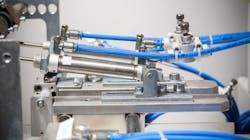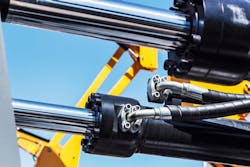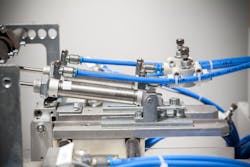Once every 2 years the National Fluid Power Association (NFPA) updates its Technology Roadmap which it describes as an industry-wide consensus document on R&D needs to improve the design, manufacture and function of fluid power components and systems.
These development needs are first determined by customer drivers – the business or technology objectives of those building machines into which fluid power components and systems are integrated said Eric Lanke, President and CEO of NFPA, during a webinar hosted by the association providing an analysis of the most recent Technology Roadmap.
From these drivers, the roadmap committee builds out the other aspects to be identified:
- Capability Improvements
- Research Areas
- Research Targets
To determine the industry’s needs, NFPA surveys its members and works with other industry associations such as the Power Transmission Distributors Association (PTDA) and the Association of Equipment Manufacturers (AEM). This is due to the range of applications in which fluid power technology is utilized and shared customer needs with other industries.
WATCH and LEARN MORE: IoT Has A Key Role in NFPA Roadmap
Prioritizing Customer Requirements
During NFPA’s recent webinar, Lanke overviewed key drivers outlined in the 2021 Technology Roadmap which is the most recent version; work will begin in December 2022 on the 2023 edition.
The industry’s 20 largest markets—which include heavy mobile equipment, trucking and industrial machinery—were used as the basis for exploring the key customer drivers. A broad coalition of industry stakeholders were asked to rank how important each of the customer drivers identified 2 years prior during the road mapping process were in each of the largest markets said Lanke.
Upon analyzation of this information, it was determined the top three customer drivers with applicability across almost all 20 of the largest markets were:
- increased availability and uptime,
- increased productivity and performance,
- compliance with safety regulations and machine directives.
Following these, the next in importance were:
- lower capital and operating costs,
- easier and more predictable maintenance,
- greater integration of on-board technologies.
Lanke said these drivers appear to be less universally important across all 20 markets but were among some of the most important for several such as packaging and printing machinery markets.
The least applicable customer drivers across all 20 markets were autonomous operation as well as weight reductions and increased power density. Lanke said these drivers still have some importance depending on the market but much less so compared to the other customer drivers.
READ MORE: Fluid Power Market to Continue in Positive Direction
For the 2021 Technology Roadmap, NFPA also looked for input on new customer drivers which should be taken into consideration. Based on these and the importance of the prior drivers, the Technology Roadmap committee created a final list of the top 7 customer drivers which became the basis for the 2021 edition:
- Increased availability and uptime.
- Increased productivity and performance.
- On-time delivery of the machine.
- Lower capital and operating costs.
- Compliance with environmental and safety regulations and machine directives.
- Easier and more predictable maintenance.
- Increased energy efficiency.
These customer drivers are in priority order of importance for the 20 largest markets served by fluid power as well as power transmission providers said Lanke. From these drivers the roadmap committee then determined necessary capability improvements and research areas for the industry.
The full 2021 Technology Roadmap can be downloaded from NFPA’s website.
The next Technology Road development process will begin December 1, 2022. It will be conducted in four phases:
- Phase 1 – Customer Drivers
- Phase 2 – Capability Improvements
- Phase 3 – Research Areas and Targets
- Phase 4 – Final Roadmap Document
The final document is expected to be available in August 2023. Lanke said participation from the widest possible spectrum of industry members and players is encouraged; anyone interested in being part of the committee or being surveyed can contact him to do so.
About the Author
Sara Jensen
Executive Editor, Power & Motion
Sara Jensen is executive editor of Power & Motion, directing expanded coverage into the modern fluid power space, as well as mechatronic and smart technologies. She has over 15 years of publishing experience. Prior to Power & Motion she spent 11 years with a trade publication for engineers of heavy-duty equipment, the last 3 of which were as the editor and brand lead. Over the course of her time in the B2B industry, Sara has gained an extensive knowledge of various heavy-duty equipment industries — including construction, agriculture, mining and on-road trucks —along with the systems and market trends which impact them such as fluid power and electronic motion control technologies.
You can follow Sara and Power & Motion via the following social media handles:
X (formerly Twitter): @TechnlgyEditor and @PowerMotionTech
LinkedIn: @SaraJensen and @Power&Motion
Facebook: @PowerMotionTech

Leaders relevant to this article:



